Geochemical Characteristics of Crude Oil and Oil–Source Correlations in the Yongfeng Sub-Sag of the Bogda Mountain Front Belt
Abstract
1. Introduction
2. Regional Geological Condition
3. Sample Collection and Analysis
3.1. Sample Collection
3.2. Sample Analysis Method
4. Physical Characteristics and Group Components of Crude Oil
4.1. Physical Characteristics of Crude Oil
4.2. Group Components SARA (Saturate, Aromatic, Resin, and Asphaltene) of Crude Oil
5. Geochemical Characteristics of Crude Oil
5.1. Composition and Distribution Characteristics of Alkane Series
5.2. Composition and Distribution Characteristics of Terpenoid Hopane Series
5.3. Composition and Distribution Characteristics of Sterane Series
6. Oil Maturity
7. Oil–Source Correlations
7.1. Geochemical Characteristics of Source Rocks
7.2. Multi Factor Oil–Source Correlations
7.2.1. Correlations of Carbon Isotope Composition Characteristics
7.2.2. Correlations of Distribution Characteristics of Isoprene Alkanes
7.2.3. Correlations of Distribution Characteristics of Terpenoid Compounds
8. Conclusions
Author Contributions
Funding
Data Availability Statement
Conflicts of Interest
References
- Chen, J.; Wang, X.; Ni, Y.; Xiang, B.; Liao, F.; Liao, J. The accumulation of natural gas and potential exploration regions in the southern margin of the Junggar basin. Acta Geol. Sin. 2019, 93, 1002–1019. [Google Scholar]
- Du, J.; Zhi, D.; Li, J.; Yang, D.; Tang, Y.; Qi, X.; Xiao, L.; Wei, L. Major breakthrough of Well Gaotan l and exploration prospects of lower assemblage in southern margin of Junggar basin, NW China. Pet. Explor. Dev. 2019, 46, 205–215. [Google Scholar] [CrossRef]
- Zhi, D.; Song, Y.; He, W.; Jia, X.; Zou, Y.; Huang, L. Geological characteristics, resource potential and exploration direction of shale oil in Middle-Lower Permian, Junggar Basin. Xinjiang Pet. Geol. 2019, 40, 389–401. [Google Scholar]
- Yang, Y.; Zhang, J.; Zhang, J.; Gao, Y.; Zhou, X.; Sun, X.; Wen, L.; Miao, M. Sedimentary characteristics and main controlling factors of the Middle-Upper Permian and Middle-Upper Triassic around Bogda Mountain of Xinjiang, NW China. Pet. Explor. Dev. 2022, 49, 770–784. [Google Scholar] [CrossRef]
- Wu, P.; Zhao, P.; Chen, Y.; Yang, H.; Yang, Y.; Dong, Q.; Chang, Y.; Wen, L.; Yuan, K.; Du, Y.; et al. Tight Reservoir Characteristics and Controlling Factors of Permian Lucaogou Formation in Yongfeng Sub-Sag, Chaiwopu Sag. Processes 2023, 11, 3068. [Google Scholar] [CrossRef]
- Sun, X.; Chen, Y.; Zhou, X.; Bai, Z.; Du, Y.; Wen, L.; Yuan, K. Characteristics and Origin of Natural Gas in Yongfeng Sub-Sag of Bogda Mountain Front Belt. Appl. Sci. 2024, 14, 9085. [Google Scholar] [CrossRef]
- Jin, Z.; Zhu, R.; Liang, X.; Shen, Y. Several issues worthy of attention in current lacustrine shale oil exploration and development. Pet. Explor. Dev. 2021, 48, 1276–1287. [Google Scholar] [CrossRef]
- Qiu, Z.; Shi, Z.; Dong, D.; Lu, B.; Zhang, C.; Zhou, J.; Wang, H.; Xiong, B.; Pang, Z.; Guo, H. Geological characteristics of source rock and reservoir of tight oil and its accumulation mechanism: A case study of Permian Lucaogou Formation in Jimusar sag, Junggar Basin. Pet. Explor. Dev. 2016, 43, 928–939. [Google Scholar] [CrossRef]
- Song, Y.; Luo, Q.; Jiang, Z.; Yang, W.; Liu, D. Enrichment of tight oil and its controlling factors in central and western China. Pet. Explor. Dev. 2021, 48, 492–506. [Google Scholar] [CrossRef]
- Zhi, D.; Xie, A.; Yang, F.; Ma, Q.; He, C.; Gou, H. Exploration prospects of the whole oil and gas system in the Permian hydrocarbon depressions in the Eastern Junggar Basin. J. Geomech. 2024, 30, 781–794. [Google Scholar]
- Yang, Y.; Zheng, X.; Xiao, Y.; Lei, Z.; Xing, H.; Xiong, T.; Liu, M.; Liu, S.; Hou, M.; Zhang, Y. Progress in exploration and development of high-mature shale oil of PetroChina. China Pet. Explor. 2023, 28, 23–33. [Google Scholar]
- Wang, J.; Liu, J.; Pan, X.; Zhang, B.; Li, E.; Zhou, X. Precursor and Mechanism of Hydrocarbon Generation for Shale Oil in Lucaogou Formation, Jimsar Sag. Xinjiang Pet. Geol. 2024, 45, 253–261. [Google Scholar]
- Jia, C.; Wang, Z.; Jiang, L.; Zhao, W. Progress and key scientific and technological problems of shale oil exploration and development in China. World Pet. Ind. 2024, 31, 1–11. [Google Scholar]
- Cao, Z.; Zhou, C.; Gong, D.; Wang, R.; Ding, L.; Yang, C.; Zhang, Z. Tectono-lithofacies paleogeographic characteristics and source rock distribution of the Middle-Lower Permian in Junggar Basin. Acta Pet. Sin. 2024, 45, 1349–1371. [Google Scholar]
- Price, L.C. Thermal stability of hydrocarbons in nature: Limits, evidence, characteristics, and possible controls. Geochim. Cosmochim. Acta 1993, 57, 3261–3280. [Google Scholar] [CrossRef]
- Kruge, M.A.; Hubert, J.F.; Akes, R.J.; Meriney, P.E. Biological markers in Lower Jurassic synrift lacustrine black shales, Hartford basin, Connecticut, U.S.A. Org. Geochem. 1990, 15, 281–289. [Google Scholar] [CrossRef]
- Chandra, K.; Mishra, C.S.; Samanta, U.; Gupta, A.; Mehrotra, K.L. Correlation of different maturity parameters in the Ahmedabad-Mehsana block of the Cambay basin. Org. Geochem. 1994, 21, 313–321. [Google Scholar] [CrossRef]
- Bao, J.; Zhu, C.; Wang, L. Geochemical characteristic comparison of crude oil samples from the western Qaidam Basin. Oil Gas Geol. 2010, 31, 353–359. [Google Scholar]
- Zhang, M.; Liu, C.; Tian, J.; Pang, H.; Zeng, X.; Kong, H.; Yang, S. Characteristics of crude oil geochemical characteristics and oil source comparison in the western part of Qaidam Basin. Nat. Gas Geosci. 2020, 31, 61–72. [Google Scholar]
- Ourisson, G.; Albrecht, P.; Rohmer, M. Predictive microbial biochemistry—From molecular fossils to procaryotic membranes. Trends Biochem. Sci. 1982, 7, 236–239. [Google Scholar] [CrossRef]
- Revill, A.T.; Volkman, J.K.; O’Leary, T.; Summons, R.E.; Boreham, C.J.; Banks, M.R.; Denwer, K. Hydrocarbon biomarkers, thermal maturity, and depositional setting of tasmanite oil shales from Tasmania, Australia. Geochim. Cosmochim. Acta 1994, 58, 3803–3822. [Google Scholar] [CrossRef]
- Philp, R.P.; Gilbert, T.D. Biomarker distributions in Australian oils predominantly derived from terrigenous source material. Org. Geochem. 1986, 10, 73–84. [Google Scholar] [CrossRef]
- Boreham, C.J.; Blevin, J.E.; Radlinski, A.P.; Trigg, K.R. Coal as a source of oil and gas: A case study from the Bass basin, Australia. Appea J. 2003, 43, 117–148. [Google Scholar] [CrossRef]
- Moldowan, J.M.; Seifert, W.K.; Gallegos, E.J. Identification of an extended series of tricyclic terpanes in petroleum. Geochim. Et Cosmochim. Acta 1983, 47, 1531–1534. [Google Scholar] [CrossRef]
- Damsté, J.S.S.; Kenig, F.; Koopmans, M.P.; Koster, J.; Schouten, S.; Hayes, J.M.; De Leeuw, J.W. Evidence for gammacerane as an indicator of water column stratification. Geochim. Cosmochim. Acta 1995, 59, 1895–1900. [Google Scholar] [CrossRef] [PubMed]
- Huang, W.Y.; Meinschein, W.G. Sterols as ecological indicators. Geochim. Cosmochim. Acta 1979, 43, 739–745. [Google Scholar] [CrossRef]
- Walters, C.C. The Biomarker Guide; Cambridge University Press: Cambridge, UK, 2005; pp. 322–352. [Google Scholar]
- Moldowan, J.M.; Seifert, W.K.; Gallegos, E.J. Relationship between petroleum composition and depositional environment of petroleum source rocks. Am. Assoc. Pet. Geol. Bull. 1985, 69, 1255–1268. [Google Scholar]
- Radke, M.; Vriend, S.P.; Ramanampisoa, L.R. Alkyldibenzofurans in terrestrial rocks: Influence of organic facies and maturation. Geochim. Cosmochim. Acta 2000, 64, 275–286. [Google Scholar] [CrossRef]
- Boreham, C.J.; Crick, I.H.; Powell, T.G. Alternative calibration of the Methylphenanthrene Index against vitrinite reflectance: Application to maturity measurements on oils and sediments. Org. Geochem. 1988, 12, 289–294. [Google Scholar] [CrossRef]
- Li, M.; Shi, S.; Wang, T.; Fang, R.; Zhu, L. The identification of C3- and C4- alkylated dibenzothiophenes in petroleum and sedimentary organic matter. Geochimica 2014, 43, 157–165. [Google Scholar]
- Chen, J.; Liang, D.; Wang, X.; Deng, C.; Xue, X.; Jin, T.; Song, F.; Zhong, N. Oil-source identification for the mixed oils derived from multiple source rocks in the Cainan Oilfield, Junggar Basin, Northwest China. Part I: Fundamental geochemical features of source rocks. Pet. Explor. Dev. 2003, 30, 20–24. [Google Scholar]
- Wang, J.; Li, E.; Chen, J.; Mi, J.; Ma, C.; Lei, H.; Xie, L. Characteristics and hydrocarbon generation mechanism of high- quality source rocks in Permian Lucaogou Formation, Jimsar Sag, Junggar Basin. Geol. Rev. 2020, 66, 755–764. [Google Scholar]
- Volkman, J.K. A review of sterol markers for marine and terrigenous organic matter. Org. Geochem. 1986, 9, 83–99. [Google Scholar] [CrossRef]

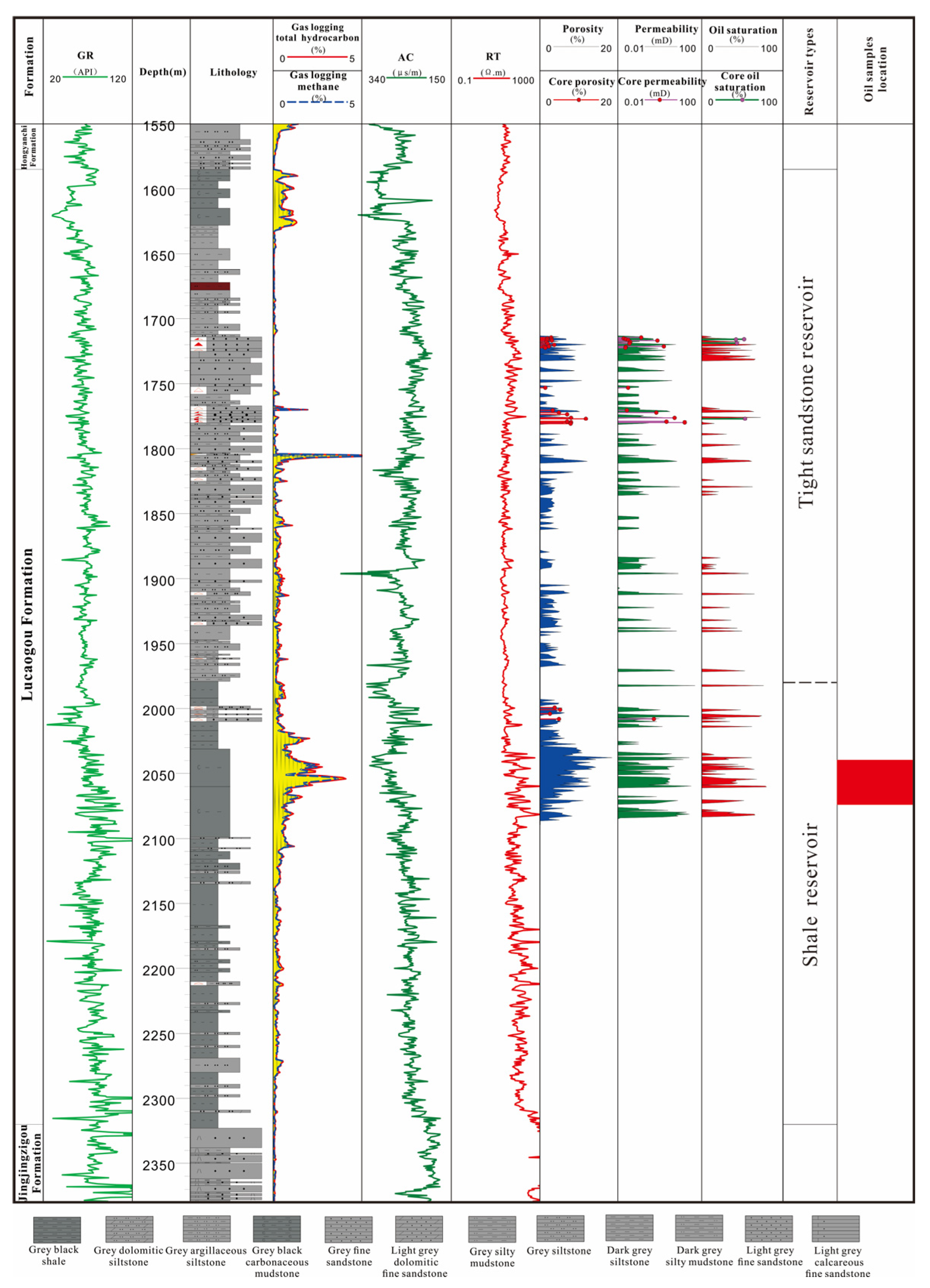
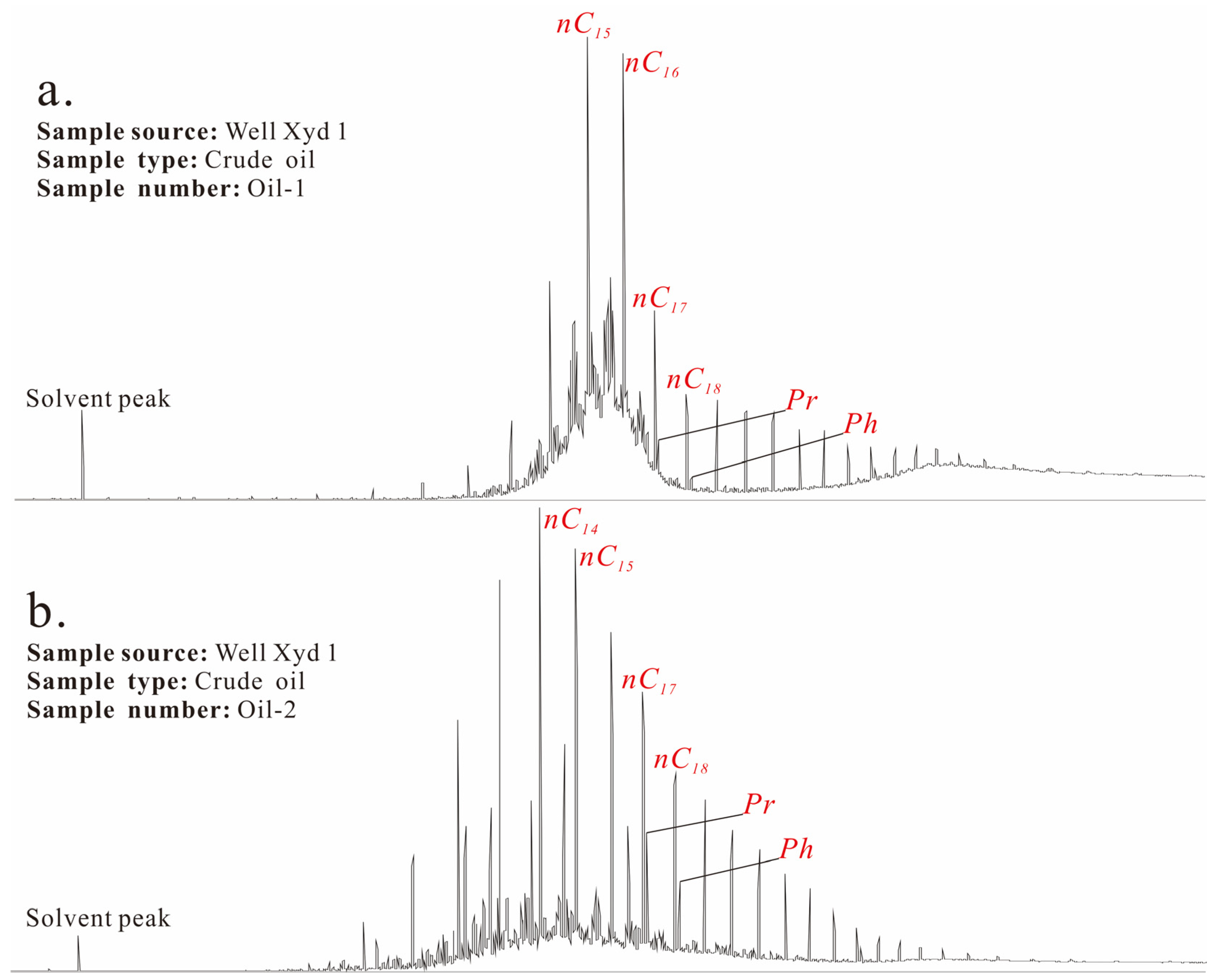
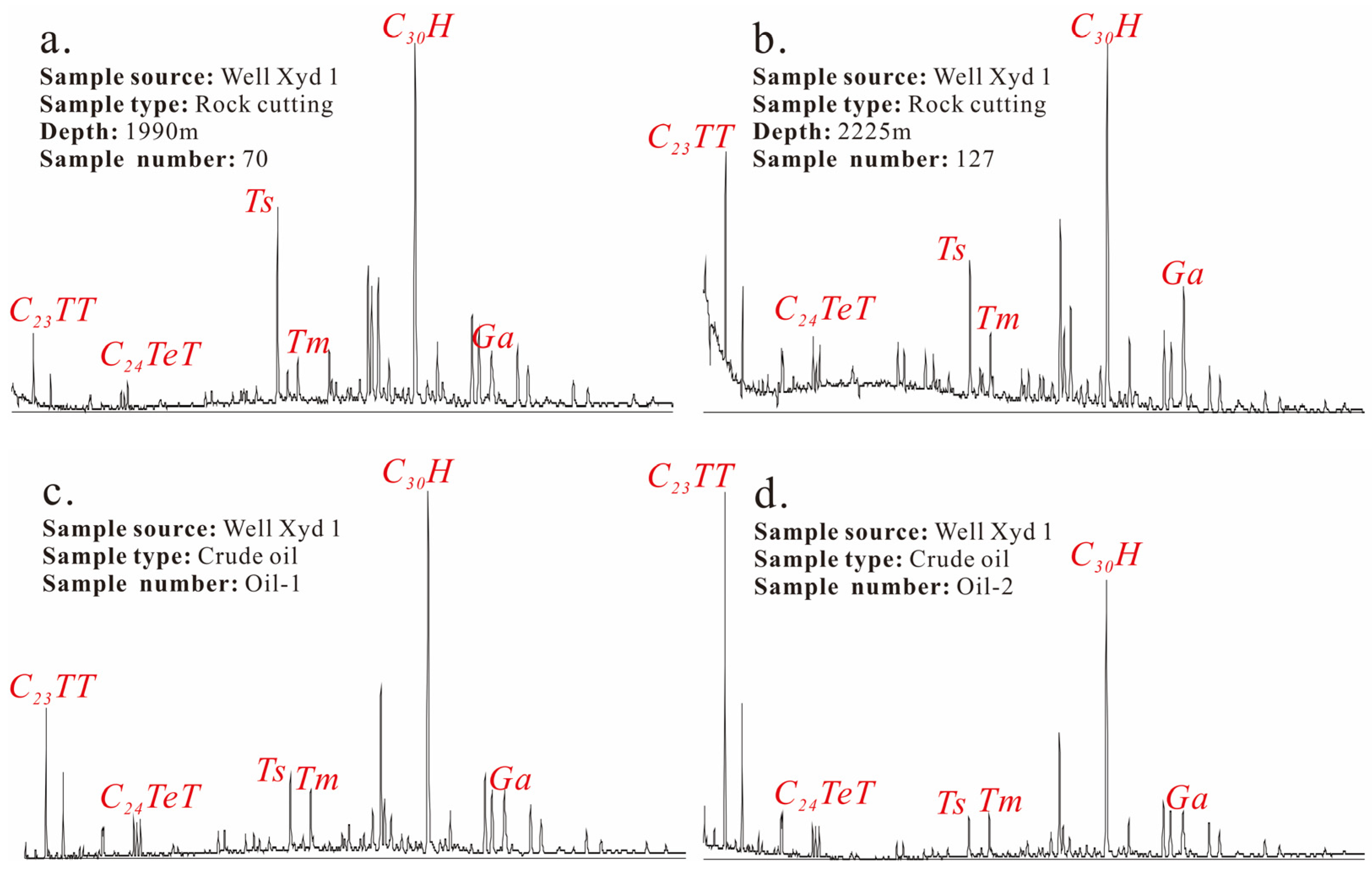
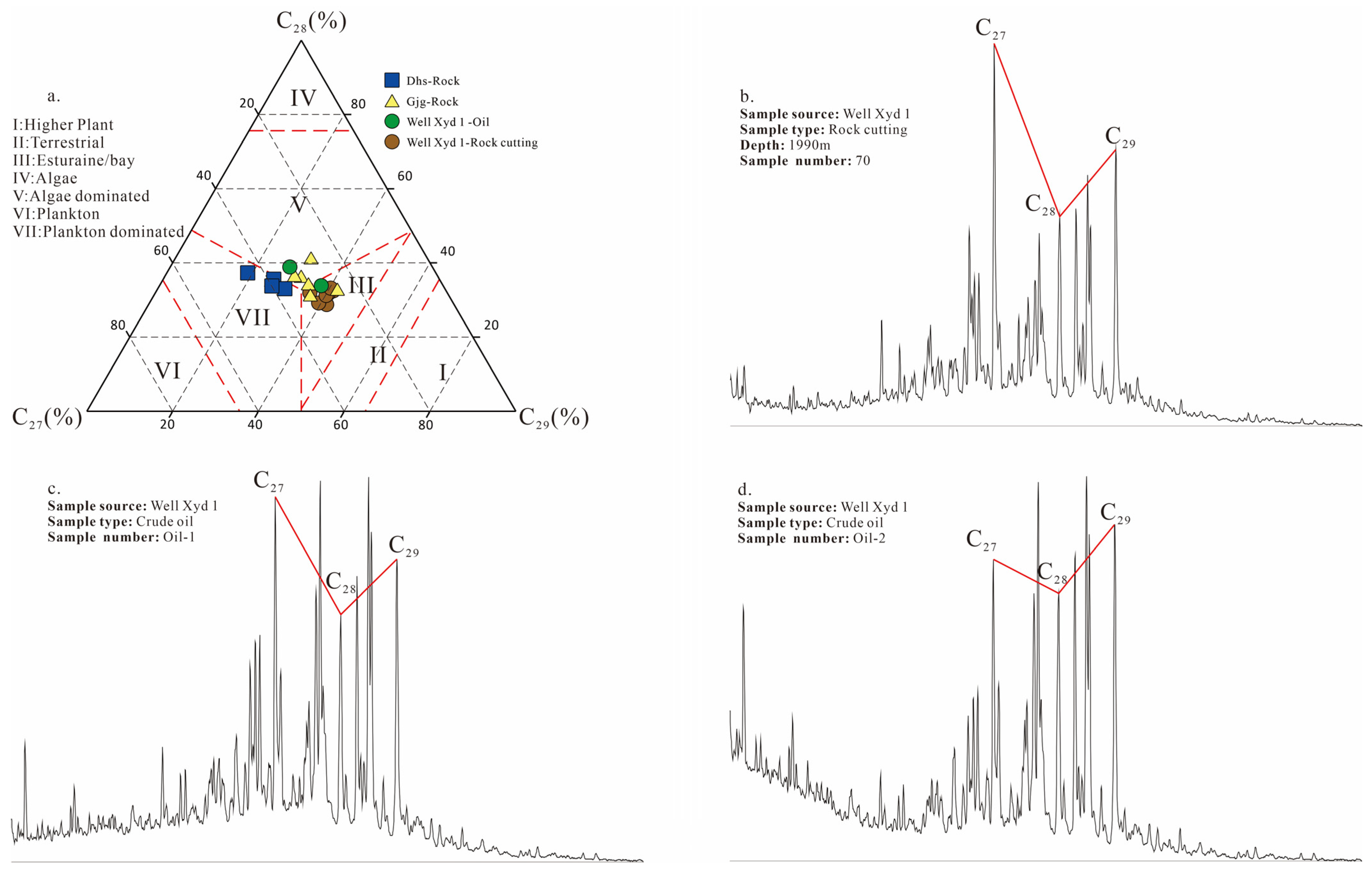
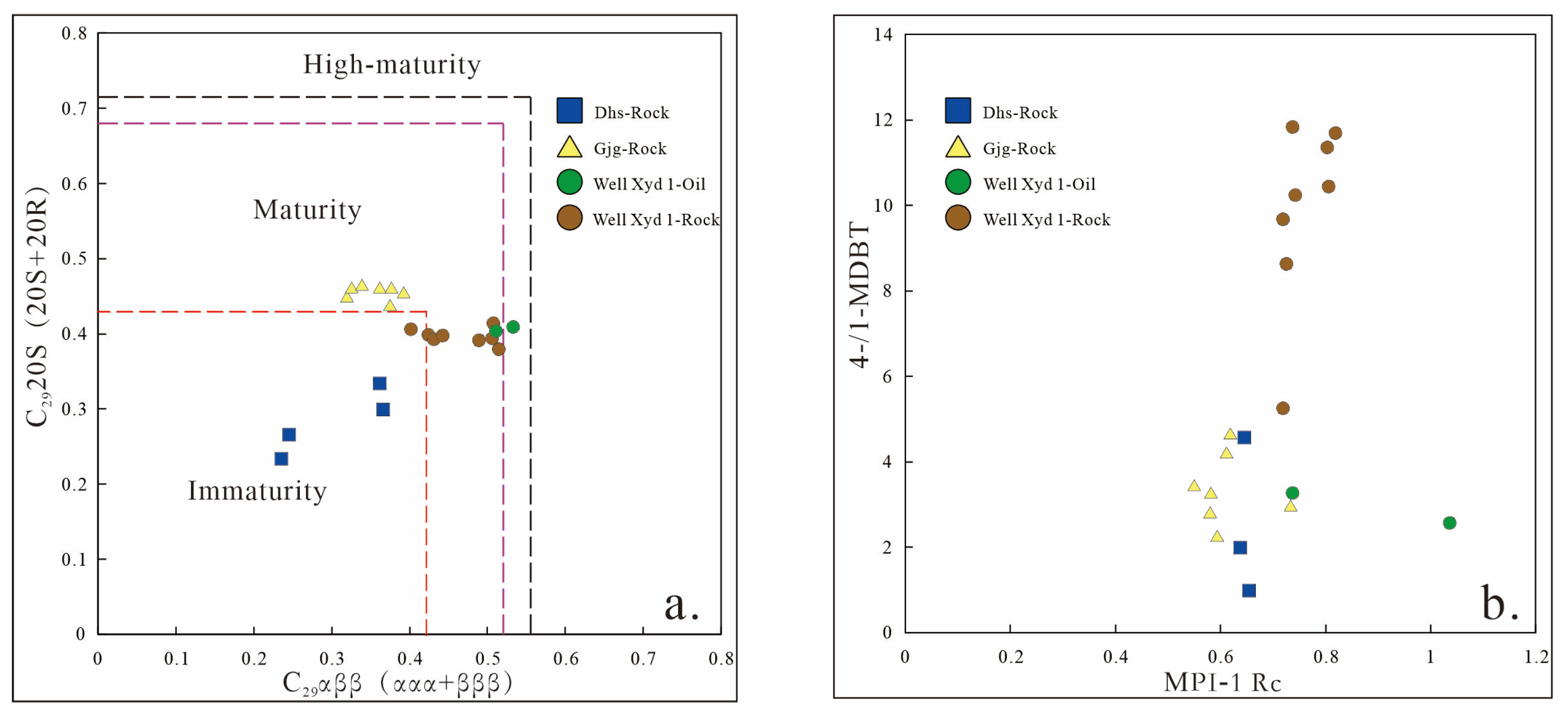
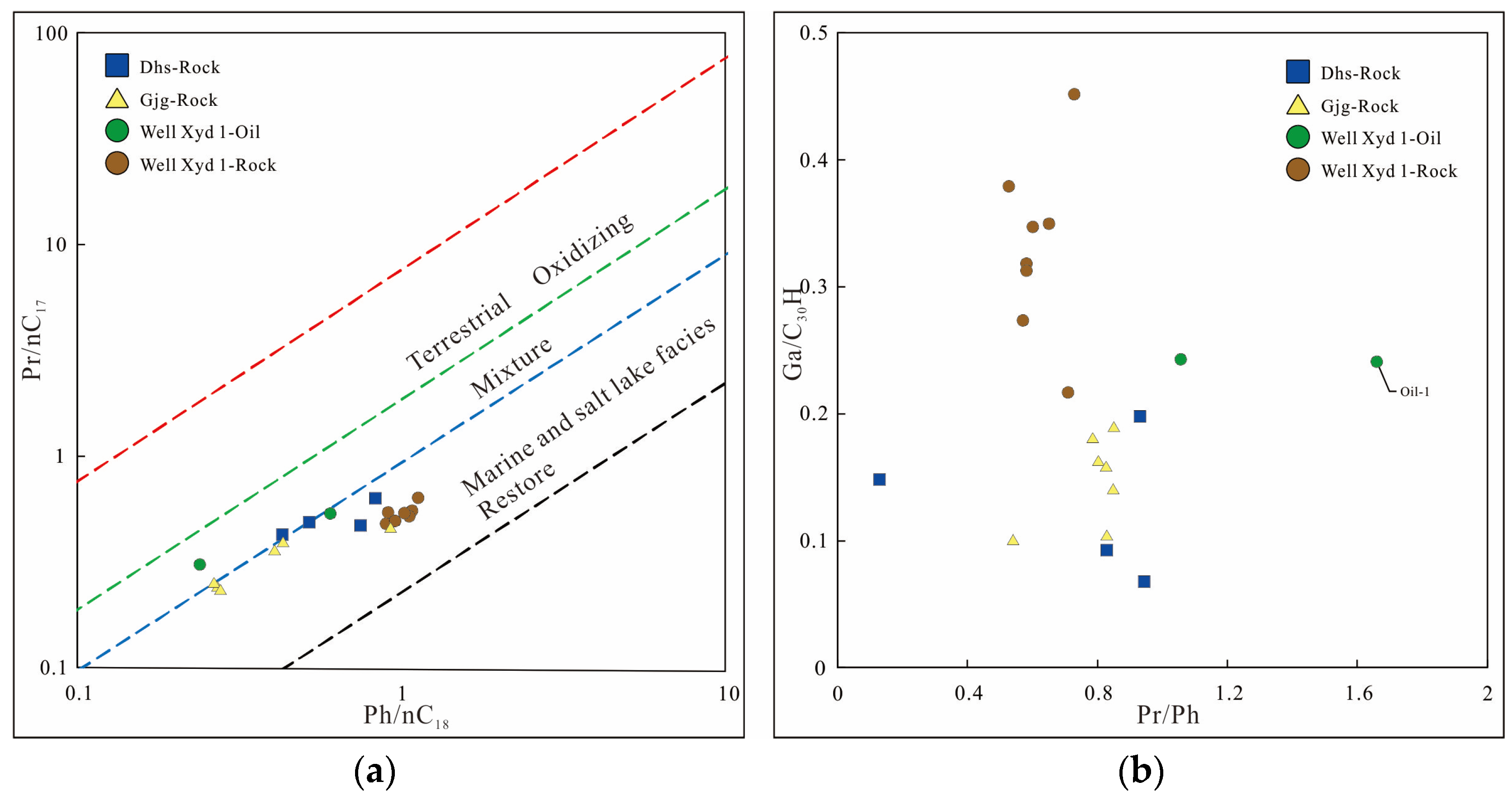
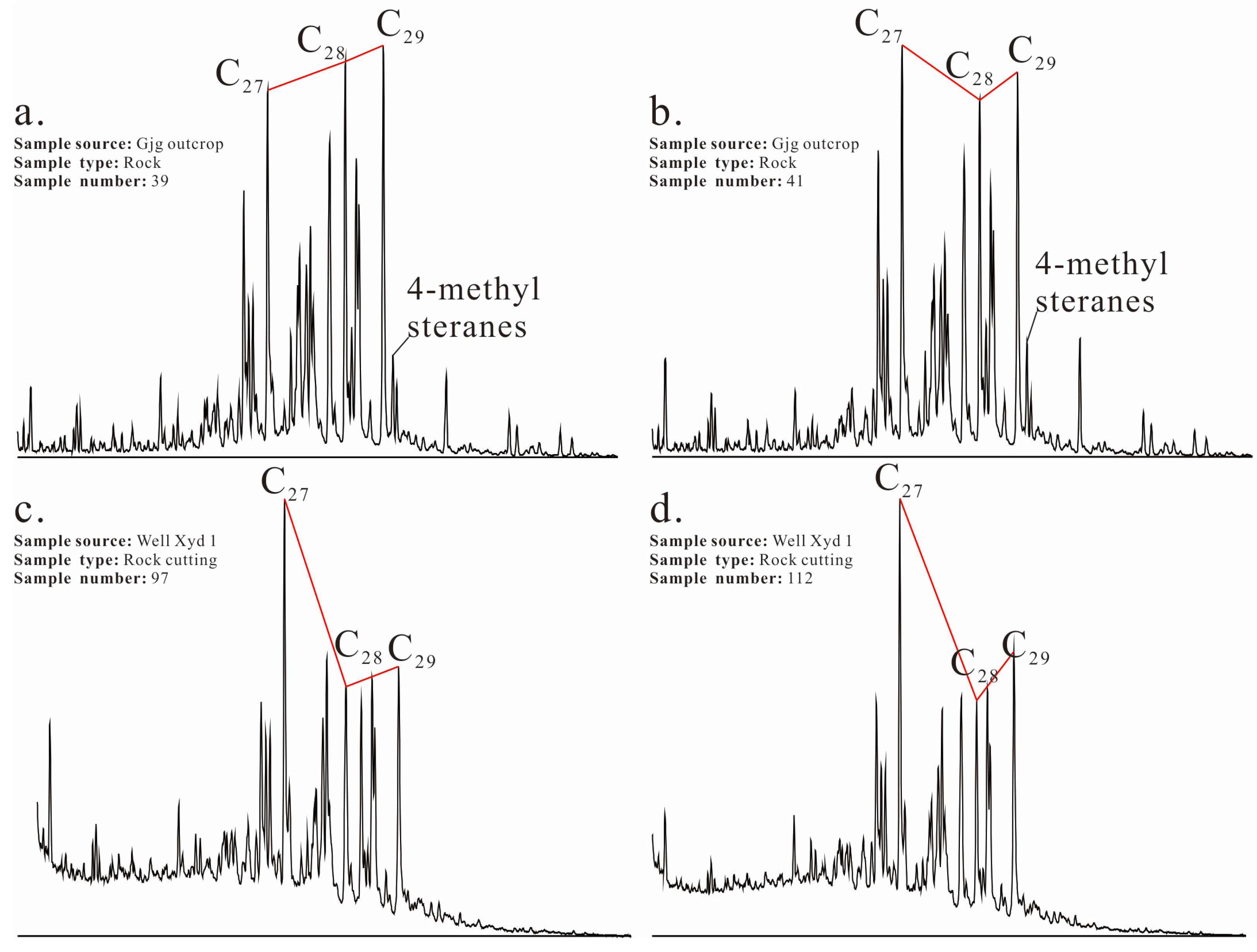
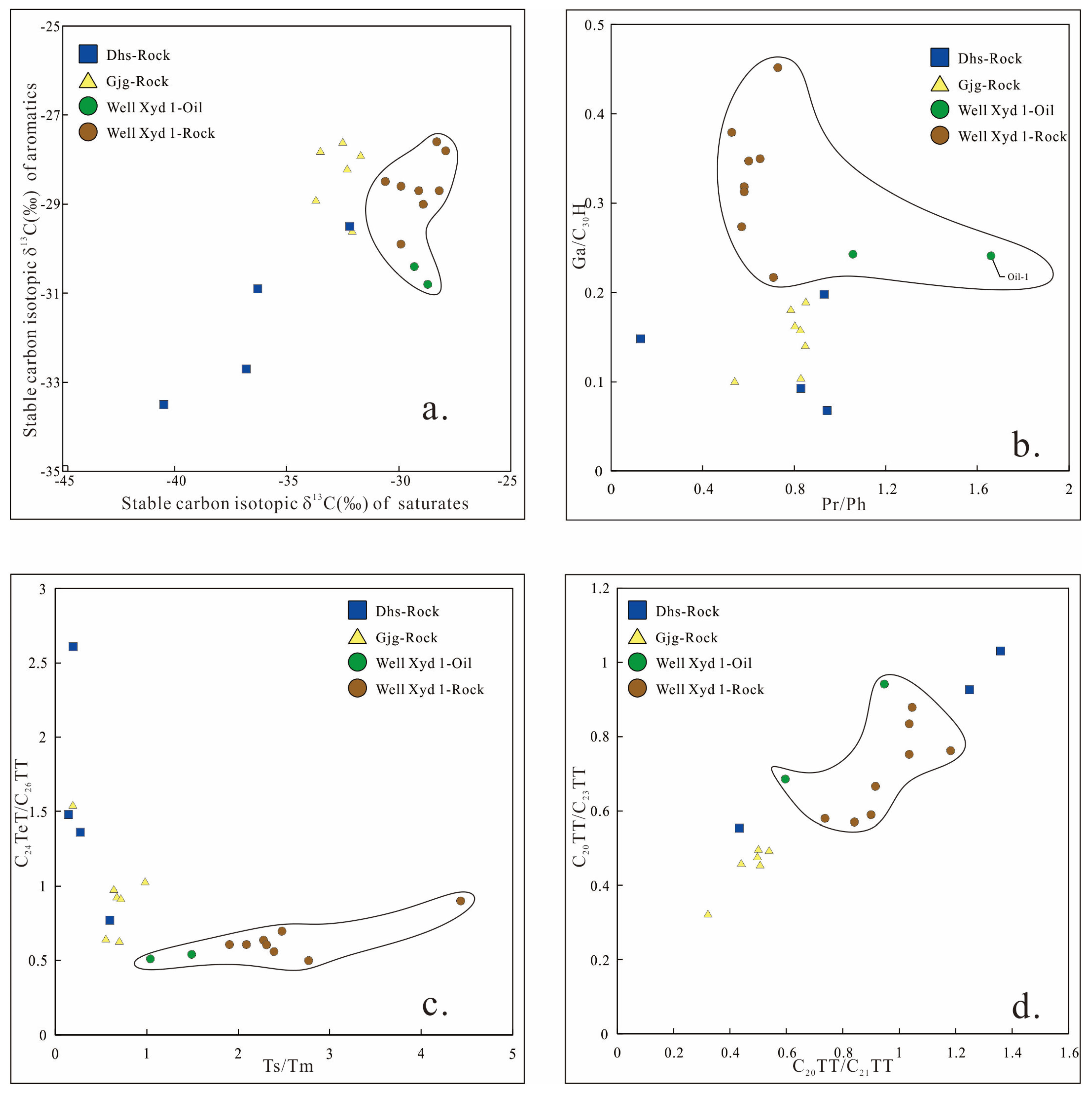
| Sample Source | Sample No. | Type | Saturate /% | Aromatic /% | Resin /% | Asphaltene /% | Resin and Asphaltene /% | Collection Rate /% | Saturates/Aromatics |
|---|---|---|---|---|---|---|---|---|---|
| Well Xyd 1 | 70 | Rock cutting | 52.33 | 11.66 | 18.65 | 15.54 | 34.19 | 98.19 | 4.49 |
| 91 | 19.43 | 8.57 | 32.00 | 35.43 | 67.43 | 95.43 | 2.27 | ||
| 97 | 27.22 | 20.71 | 33.14 | 15.98 | 49.12 | 97.04 | 1.31 | ||
| 102 | 32.43 | 9.26 | 35.97 | 16.89 | 52.86 | 94.55 | 3.50 | ||
| 112 | 40.60 | 12.26 | 26.98 | 14.99 | 41.97 | 94.82 | 3.31 | ||
| 117 | 40.40 | 19.19 | 22.90 | 8.42 | 31.32 | 90.91 | 2.11 | ||
| 121 | 29.90 | 19.28 | 29.74 | 16.99 | 46.73 | 95.92 | 1.55 | ||
| 127 | 35.03 | 18.84 | 29.94 | 10.52 | 40.46 | 94.34 | 1.86 | ||
| Oil-1 | Crude oil | 59.96 | 17.68 | 10.57 | 3.25 | 13.82 | 91.46 | 3.39 | |
| Oil-2 | 54.25 | 15.33 | 10.85 | 4.95 | 15.80 | 85.38 | 3.54 | ||
| Gjg outcrop | 35 | Rock | 25.62 | 23.14 | 28.51 | 19.83 | 48.34 | 97.11 | 1.11 |
| 37 | 23.21 | 20.98 | 34.37 | 18.75 | 53.12 | 97.32 | 1.11 | ||
| 39 | 28.07 | 17.84 | 33.63 | 14.91 | 48.54 | 94.44 | 1.57 | ||
| 41 | 23.62 | 15.35 | 38.19 | 14.57 | 52.76 | 91.73 | 1.54 | ||
| 43 | 27.40 | 15.75 | 33.33 | 18.95 | 52.28 | 95.43 | 1.74 | ||
| 45 | 23.66 | 10.22 | 39.25 | 21.51 | 60.76 | 94.62 | 2.32 | ||
| 47 | 19.88 | 16.67 | 30.92 | 26.91 | 57.83 | 94.38 | 1.19 | ||
| Dhs outcrop | 12 | Rock | 23.08 | 15.38 | 50.00 | 7.69 | 57.69 | 96.15 | 1.50 |
| 15 | 18.93 | 10.44 | 65.78 | 4.37 | 70.15 | 99.51 | 1.81 | ||
| 18 | 19.00 | 8.50 | 57.25 | 5.00 | 62.25 | 89.75 | 2.24 | ||
| 21 | 23.25 | 11.81 | 56.83 | 5.90 | 62.73 | 97.79 | 1.97 |
| Sample Source | Sample No. | Type | Pr /Ph | Pr/nC17 | Ph/nC18 | Ga/ C30H | Ts/Tm | C24TET/C26TT | MPI-1 | Rc /% | 4-/1-MDBT | C29-αββ/(αββ + ααα) | C29-ααα20S/(20S + 20R) |
|---|---|---|---|---|---|---|---|---|---|---|---|---|---|
| Well Xyd 1 | 70 | Rock cutting | 0.71 | 0.42 | 0.58 | 0.22 | 4.43 | 0.90 | 0.51 | 0.72 | 5.26 | 0.44 | 0.40 |
| 91 | 0.58 | 0.48 | 0.89 | 0.31 | 2.28 | 0.64 | 0.51 | 0.72 | 9.68 | 0.51 | 0.40 | ||
| 97 | 0.57 | 0.49 | 0.95 | 0.27 | 2.48 | 0.70 | 0.54 | 0.74 | 11.83 | 0.49 | 0.39 | ||
| 102 | 0.58 | 0.54 | 1.03 | 0.32 | 2.77 | 0.50 | 0.52 | 0.73 | 8.64 | 0.51 | 0.38 | ||
| 112 | 0.60 | 0.55 | 1.07 | 0.35 | 2.09 | 0.61 | 0.55 | 0.74 | 10.25 | 0.43 | 0.39 | ||
| 117 | 0.53 | 0.53 | 1.05 | 0.38 | 1.91 | 0.61 | 0.66 | 0.80 | 11.36 | 0.42 | 0.40 | ||
| 121 | 0.65 | 0.54 | 0.90 | 0.35 | 2.39 | 0.56 | 0.67 | 0.81 | 10.44 | 0.51 | 0.41 | ||
| 127 | 0.73 | 0.64 | 1.12 | 0.45 | 2.31 | 0.60 | 0.69 | 0.82 | 11.69 | 0.40 | 0.41 | ||
| Oil-1 | Crude oil | 1.66 | 0.31 | 0.24 | 0.24 | 1.49 | 0.54 | 0.54 | 0.74 | 3.27 | 0.53 | 0.41 | |
| Oil-2 | 1.06 | 0.54 | 0.60 | 0.24 | 1.04 | 0.51 | 1.08 | 1.04 | 2.57 | 0.51 | 0.40 | ||
| Gjg outcrop | 35 | Rock | 0.79 | 0.25 | 0.26 | 0.18 | 0.55 | 0.65 | 0.32 | 0.62 | 4.67 | 0.33 | 0.46 |
| 37 | 0.54 | 0.48 | 0.92 | 0.10 | 0.19 | 1.55 | 0.55 | 0.74 | 2.98 | 0.37 | 0.44 | ||
| 39 | 0.83 | 0.36 | 0.40 | 0.10 | 0.98 | 1.03 | 0.20 | 0.55 | 3.45 | 0.39 | 0.46 | ||
| 41 | 0.85 | 0.40 | 0.43 | 0.14 | 0.70 | 0.63 | 0.31 | 0.61 | 4.22 | 0.38 | 0.46 | ||
| 43 | 0.83 | 0.48 | 0.52 | 0.16 | 0.72 | 0.92 | 0.26 | 0.58 | 3.27 | 0.36 | 0.46 | ||
| 45 | 0.80 | 0.24 | 0.27 | 0.16 | 0.68 | 0.92 | 0.29 | 0.60 | 2.27 | 0.34 | 0.47 | ||
| 47 | 0.85 | 0.24 | 0.27 | 0.19 | 0.64 | 0.98 | 0.26 | 0.58 | 2.82 | 0.32 | 0.45 | ||
| Dhs outcrop | 12 | Rock | 0.15 | 0.47 | 0.74 | 0.15 | 0.59 | 0.77 | / | / | / | 0.37 | 0.30 |
| 15 | 0.93 | 0.49 | 0.52 | 0.20 | 0.14 | 1.48 | 0.39 | 0.65 | 0.98 | 0.36 | 0.33 | ||
| 18 | 0.94 | 0.43 | 0.43 | 0.07 | 0.19 | 2.61 | 0.37 | 0.65 | 4.57 | 0.25 | 0.27 | ||
| 21 | 0.83 | 0.63 | 0.82 | 0.09 | 0.27 | 1.36 | 0.36 | 0.64 | 1.99 | 0.24 | 0.23 |
Disclaimer/Publisher’s Note: The statements, opinions and data contained in all publications are solely those of the individual author(s) and contributor(s) and not of MDPI and/or the editor(s). MDPI and/or the editor(s) disclaim responsibility for any injury to people or property resulting from any ideas, methods, instructions or products referred to in the content. |
© 2025 by the authors. Licensee MDPI, Basel, Switzerland. This article is an open access article distributed under the terms and conditions of the Creative Commons Attribution (CC BY) license (https://creativecommons.org/licenses/by/4.0/).
Share and Cite
Sun, X.; Wu, J.; Zhou, X.; Gao, Y.; Yang, Y.; Bai, Z.; Yuan, K.; Wen, L.; Chen, Y. Geochemical Characteristics of Crude Oil and Oil–Source Correlations in the Yongfeng Sub-Sag of the Bogda Mountain Front Belt. Energies 2025, 18, 917. https://doi.org/10.3390/en18040917
Sun X, Wu J, Zhou X, Gao Y, Yang Y, Bai Z, Yuan K, Wen L, Chen Y. Geochemical Characteristics of Crude Oil and Oil–Source Correlations in the Yongfeng Sub-Sag of the Bogda Mountain Front Belt. Energies. 2025; 18(4):917. https://doi.org/10.3390/en18040917
Chicago/Turabian StyleSun, Xiangcan, Jianwei Wu, Xingui Zhou, Yongjin Gao, Youxing Yang, Zhongkai Bai, Kun Yuan, Lei Wen, and Yi Chen. 2025. "Geochemical Characteristics of Crude Oil and Oil–Source Correlations in the Yongfeng Sub-Sag of the Bogda Mountain Front Belt" Energies 18, no. 4: 917. https://doi.org/10.3390/en18040917
APA StyleSun, X., Wu, J., Zhou, X., Gao, Y., Yang, Y., Bai, Z., Yuan, K., Wen, L., & Chen, Y. (2025). Geochemical Characteristics of Crude Oil and Oil–Source Correlations in the Yongfeng Sub-Sag of the Bogda Mountain Front Belt. Energies, 18(4), 917. https://doi.org/10.3390/en18040917






